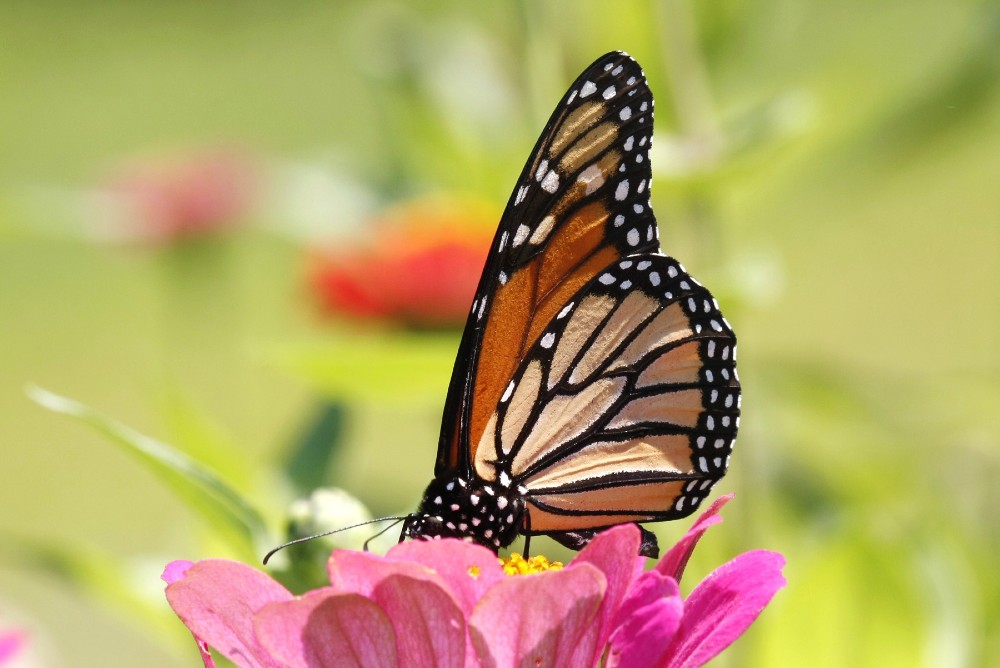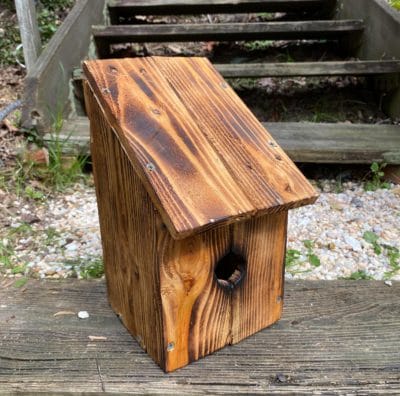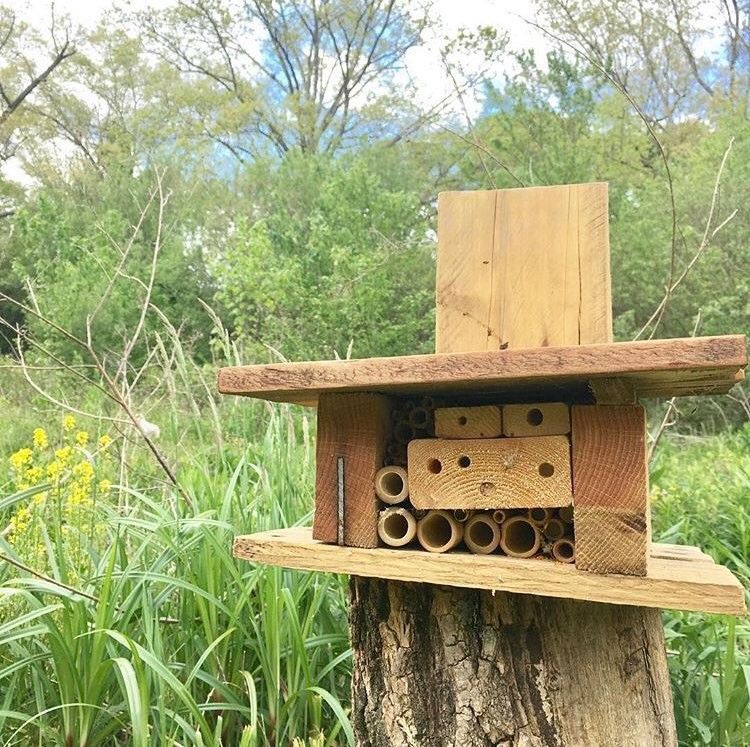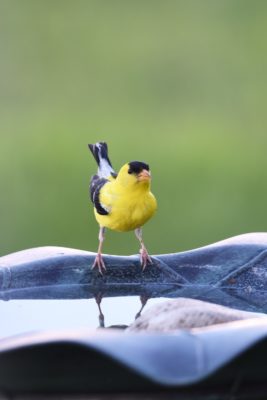5 Tips to Create Habitat in a Small Space

Spring has finally arrived and it’s the perfect time to add or improve wildlife habitat, especially in small spaces. Have you wanted to create a wildlife-friendly landscape, but not sure how due to limited outdoor space or resources? We’ve listed five ways you can help wildlife thrive in even the smallest spaces, whether it’s a concrete patio, small green space, or a raised deck.
1. Plant Native
Planting native is one of the simplest and most effective ways to support wildlife. It’s number one on our list because it is key to a habitat-friendly backyard. Native plants are already accustomed to the local environment and don’t require any additional upkeep such as excessive watering or pruning.
In a small outdoor area, you can set a couple of flower pots next to your front door or within your deck or patio space. To save space, you can also use hanging planters, window or railing planters.
What Types of Wildlife Do You Want to Attract?
Since pollinators have shaped their lives around native plants, it is most beneficial to continue their succession. Also keep in mind that certain species will offer seasonal berries, seeds, and support insects more than others. First, choose native plants that aren’t too large and make sure they support the wildlife you’re planning to attract. Your plants will determine which birds and insects visit.
According to the National Audubon Society, bird-plant relationships are so intertwined that gardeners can attract specific species by offering the right plants. Here’s their database of native plants to find out which species are best suited for planting in your area.

Natives We Recommend for Local Wildlife:
Orange Milkweed AKA Butterfly Milkweed (Asclepias tuberosa)
- Clusters of bright orange flowers, attracting both butterflies and hummingbirds
- Serves as an important host plant for monarchs and supports many insects
- Monarch butterflies lay their eggs exclusively on milkweeds, the only plants their caterpillars can eat
- Drought tolerant and grows in full sun
- Blooms in summer
Cardinal Flower (Lobelia cardinalis)
- Tall and narrow-growing perennial
- Produces bright red flowers from mid-summer to fall
- Tubular shaped flowers provide nectar for ruby-throated hummingbirds
- Cannot tolerate dry soil conditions and grow best in wet soils
- Can sit the flower pot on a plate of two inches of water to help saturate its roots

Bee Balm AKA Wild Bergamot
(Monarda fistulosa)
- Grows up to 4 feet tall
- Clusters of lavender, pink, or white flowers resembling ragged pompoms
- Highly fragrant, attractive to hummingbirds, butterflies, and bees
- Blooms in summer with full sun or partial shade
Coral Honeysuckle
(Lonicera sempervirens)
- A native vine, grows vertically on a trellis or as a groundcover
- Provides nectar for hummingbirds
- Hosts Spring Azure Butterflies and Snowberry Clearwing Moths.
Purple Coneflower (Echinacea purpurea)
- Excellent source of nectar for butterflies
- Songbirds, especially goldfinches, love to feed on the dry seeds
Firewheel (Gaillardia pulchella)
- This bright flower is a surely a showstopper with its bright red petals, dark red center, and yellow trim
- Part of the sunflower family, it provides plentiful seeds for birds
It’s even a good idea to include plants that flower or fruit during different times of the year, so you will always have something in season for wildlife. Here’s an article featuring the best winter berry plants for birds to help them through the colder months.
2. Add a Birdhouse

Since there aren’t enough natural hollows to go around, a birdhouse is a great way to provide habitat for vulnerable bird species. You can either build your own or buy one based on the species you’re hoping to attract.
First, see if you can mount a birdhouse to your building or atop a sturdy pole. Also, consider if birds using it can live undisturbed by both cats and dogs. If you live in a rented apartment complex or have limited outdoor space, you can get very creative with this!
Here are a few ideas:
- First floor tenants can mount or tie a birdhouse with cord to a supportive column
- Second floor tenants could tie the birdhouse to the deck railing
- Consider nearby trees
If you’re hoping to attract specific species, The Cornell Lab of Ornithology’s NestWatch program provides nest box plans for birds in your area. Learn more about our local bird species and the types of habitat they need.
3. Build a Bee Hotel
Mining bees, mason bees, and leafcutter bees are essential and valuable pollinators for every backyard habitat. Although they are solitary and pollinate flowers on their own, most do like to live in close proximity to one another, just not in the social confines of a hive. They prefer to nest in narrow tubular spaces resembling the hollow of a reed or a crevice in a wall.

It’s not easy for a small bee to find the perfect home, especially in a city, so if you can create the ideal living space, they will be more than grateful! If you’re looking for a new outdoor project, building a bee home isn’t difficult, and it’s well worth the extra effort to allow these pollinators to neighbor your nearby flowers.
Learn more about our local bee species.

4. Provide Water with a Birdbath or Fountain
Adding a birdbath or fountain is the easiest way to provide drinking and bathing water for birds, insects, and even amphibians. It also adds to a calming atmosphere and serves as a great way to block out noise from nearby busy roads or highways.
You can buy or make a small hanging bath, or buy a standing bath to match your decor.
5. Hang a Bird Feeder
Birds prefer some seeds over others, and depending on the species you want to attract, it’s best to find out which birds frequent your area, and decide which seeds to provide. We really like this article from EarthEasy, which tells you how to attract birds to your feeder, listing various seed types.
Don’t forget the hummingbirds! If you’re looking to attract hummingbirds, you can purchase a hummingbird feeder, which come in various shapes and sizes. Fill the feeder with sugar water, mixing one part white sugar to four parts water. Bring to a boil and let cool, and then add it to your feeder. Be sure to change the solution every couple days to prevent mold. Hummingbirds also love to draw nectar from bright flowers like the bee balm, cardinal flower, and coral honeysuckle recommended above (which offers more nutrition.)
Any outdoor space, no matter how small, can become an effective habitat for wildlife.
If you provide food, water, and shelter, a small area can also become buzzing with birds, bees, and butterflies. Adding native plants, a birdbath or house, or even a petite waterfall pond can make for an aesthetically pleasing outdoor space that is enjoyable for both you and important pollinators. Keep these tips from Conserving Carolina in mind as you plan your backyard habitat to get the most out of a small space and make it into the wildlife sanctuary of your dreams!
Habitat at Home is a monthly segment dedicated to providing you with tips to make your yard and home a better habitat for native plants, animals, and insects. Written by Rachel Hess.